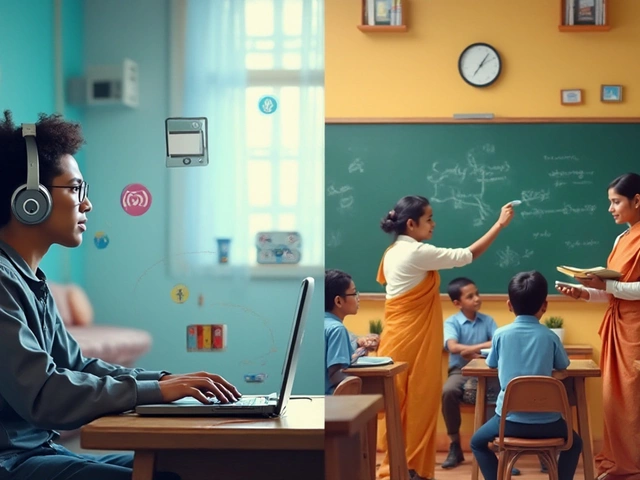Jul
23

- by Dhruv Ainsley
- 0 Comments
Picture this: you’re sitting in your favorite chair, laptop or tablet balanced on your knees, coffee in hand. The sun is barely up, or maybe it’s late at night and you’re the last one awake in your house. There’s no classroom bell, no rush-hour traffic, no scrambling to find a parking spot on campus or pay for overpriced cold sandwiches at the cafeteria. Instead, your classroom is wherever you want it to be and your schedule bends around your life—not the other way around. That’s what hooks people about distance learning, and it’s only getting bigger.
Flexibility That Actually Fits Real Life
For people who’ve got a lot going on, distance learning is a game changer. Whether you’re working full-time, taking care of kids, or living in a different time zone, these programs let you fit study sessions into your messy, busy schedule. You’re not stuck with 8 AM lectures or fighting to stay awake in a stuffy classroom after lunch. You log on when it makes sense for you.
Real story: When universities went remote during the 2020 pandemic, a massive survey by QS found that 73% of students said online classes fit their daily lives better than in-person ones did. Think about that—almost three-quarters found less stress around their routines. Distance learning often means lectures are recorded, readings are available 24/7, and assignments can be submitted at midnight if that works for you. For people with jobs or families, especially, this is a massive weight off their shoulders. Life rarely happens according to plan, so being able to pause and rewind a confusing lecture or catch up on weekends isn’t just a perk—it’s survival.
If you’re worried about missing that “classroom atmosphere,” a lot of online courses today use video calls, group chats, and even virtual lounges to recreate the community experience. The biggest difference is that you decide when to tap in and engage. That control can boost your motivation, since you study when you’re ready—no more barely absorbing info at the crack of dawn.
Expanding Access—No Matter Where You Live
Maybe the best thing about distance learning is that it flattens a lot of old barriers. If you live in a village hours from the nearest university, or you’re in a country with limited courses in your field, the internet bridges that gap. Suddenly, there’s no need to move across the country and pay sky-high city rents just to get an education. As long as you’ve got a reliable connection, you could join lectures at Harvard, Stanford, or National University of Singapore from your bedroom.
One wild stat: According to Coursera’s 2024 Global Skills Report, 43% of all new sign-ups in the past year were from rural or small-town areas. That’s up almost 20% since 2021. This is direct proof that online learning is crushing location issues. It’s also great for people with disabilities who might find classrooms and campuses hard to navigate. Most distance programs work with screen readers, captioned videos, and give longer test times when needed. If traditional education made schooling feel like an exclusive club, e-learning throws the doors wide open.
And it’s not just universities doing this. Specialized platforms offer courses in everything from marketing to python coding, creative writing to advanced math. Some are free, and many give you digital certificates, which are now popping up on real CVs and LinkedIn profiles everywhere. Students shout about the chance to mix and match courses from across the world, all without a major travel bill.
If you’ve wondered whether distance learning is taken seriously by employers, check out World Economic Forum data from 2024—it shows that 62% of recruiters now value online certificates at the same level as those from traditional schools. The gap between the two is rapidly closing, with big companies even partnering with online platforms to upskill their teams.

Learning at Your Pace: Personalizing Your Education
Ever heard someone say they wished a teacher would slow down or that a course dragged on forever? Distance learning lets you find your sweet spot. With self-paced courses, you get to revisit tough topics as often as you want, and skip the stuff you already know. That means less time wasted and a much better grip on the hard material.
There’s also less pressure compared to being “on display” in a packed classroom. If you’re the type who hates raising your hand in front of 100 people, online forums and chats can feel way safer. In 2023, a study at the University of Manchester found that student participation went up 44% in online forums versus in-person lectures. Introverts, this is your cue to shine.
Most online platforms use smart tech to help you track your progress. You might get quizzes that adapt to your strengths and weaknesses, dashboards showing which modules need more work, or emails nudging you back if you fall behind. You become the project manager of your own education, and it can be surprisingly motivating.
Another plus? Trying new things is less risky. You can take a course in Japanese or web design just to see if you like it, without the cost or pressure of a semester-long commitment. If it’s not for you, no big deal. But a lot of people stumble into passions this way.
Preparing for the Real World—Skills That Matter Now
Here’s a truth schools don’t say out loud: The traditional classroom rarely matches what life is really like. In almost every job now, you’ll be expected to solve problems online, talk to people across time zones, send emails, join Zoom meetings, and manage tasks with digital tools. Distance learning mirrors this workplace reality. You learn how to organize your time, communicate online, and stay motivated without a boss (or teacher) breathing down your neck. That’s a goldmine for employers.
Take group projects. In old-school classes, you’d huddle around a desk with your team. In distance learning, collaboration happens with Google Docs, Slack messages, or quick video calls—just like in most modern offices. You get digital skills along with your academic ones. And those soft skills—like managing your own deadlines and speaking up in online meetings—are suddenly a major part of your resume.
One thing a lot of people don’t expect is how distance learning builds self-discipline. It’s easy to lose focus without professors checking in every week, but that makes your achievements mean more. When you finish an online course (especially juggling work or family), you’ve proved you can manage your life and stick with goals over months, not just weeks.
Employers spot that. In fact, a 2024 LinkedIn survey showed that managers viewed online learners as 27% more self-directed on average than traditional grads. That’s a wild edge.
Want some tips to get the most from online learning? Set a weekly routine, even if it’s flexible. Break big projects down into small, daily tasks, and reward yourself when you hit a goal. Stay active in group chats and don’t be afraid to ask questions—the best online courses have lively communities. Most of all, keep your end goal in sight. Whether it’s a new job, a promotion, or just a new skill, define what you want and remind yourself often.
With distance learning, education isn’t just a thing you do in your twenties and finish forever. It becomes something you can reach for anytime, as life changes. It’s never been more popular, or more tailored to the way we actually live and work. Old-school classrooms might never disappear, but as more people taste the freedom and control that comes with learning from anywhere, it’s clear: distance learning isn’t just a backup plan anymore—it’s a better way for a whole new era.





